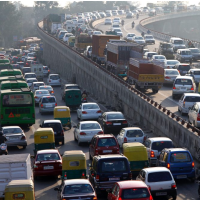Delhi is World’s Second Most Populous City, Mumbai is Sixth
 Delhi's population is 25 million (photo: Reuters)
Delhi's population is 25 million (photo: Reuters)
A recent UN report has ranked Delhi as the second most populous city in the world after Tokyo, with the capital’s population doubling since 1990 to 25 million.
Delhi is expected to retain the spot till at least 2030, when its population could balloon to 36 million, according to the report.
The 2014 revision of the World Urbanisation Prospects announced on Thursday said Mumbai, which currently ranks sixth with 21 million inhabitants, is projected to climb to fourth position by 2030 with 28 million.
Tokyo is the most populous city in the world with 38 million inhabitants and will remain at the top in 2030 with 37 million people.
India is projected to add the highest number of people – 404 million – to its urban population by 2050, way more than the projected 292 million in China and the 212 million in Nigeria.
India’s current urban population is 410 million people, and this was expected to almost double to 814 million by 2050, the report said.
This surge in migration to the cities will put severe pressure on urban infrastructure, housing, transportation, energy and employment, as well as basic services such as education and healthcare.
“Managing urban areas has become one of the most important development challenges of the 21st century. Our success or failure in building sustainable cities will be a major factor in the success of the post-2015 UN development agenda,” director of the Population Division in the UN’s Department of Economic and Social Affairs, John Wilmoth, said.
The report found that well-managed cities offer better opportunities for economic development and for expanding access to basic services, including healthcare and education. Providing such services to a densely settled urban population is also cheaper and less environmentally damaging than doing the same for a rural population that is dispersed.
"The thing to be afraid of is situations in which governments do not plan for the growth that is going to take place," Wilmoth told Reuters. "Then you can get sprawls, and slums and cities that are not pleasant places to live."
About 54 per cent of the world’s population currently lives in urban areas. This is projected to rise to 66 per cent by 2050, with the largest growth taking place in Africa and Asia.
Four cities in India with populations of between 5 million and 10 million currently – Ahmedabad, Bangalore, Chennai and Hyderabad – are expected to become megacities by 2030. India will have seven megacities by then – these four along with Kolkata, Pune and Surat.
- Top Stories
- Controversies
- Where is the Money Going?
- India and the World
- Appointments and Resignations
- Unusual News
- Latest News
- India College Chain’s Expansion into U.S. Draws Opposition from Massachusetts Officials over Quality of Education
- Milk Shortages in India Tied to Release of New Movies Featuring Nation’s Favorite Stars
- Confusion Swirls around Kashmir Newspaper Ban in Wake of Violent Street Protests
- Polio-Free for 5 Years, India Launches Vaccine Drive after Polio Strain Discovery
- New Aviation Policy Could Increase Service, Lower Ticket Prices






Comments